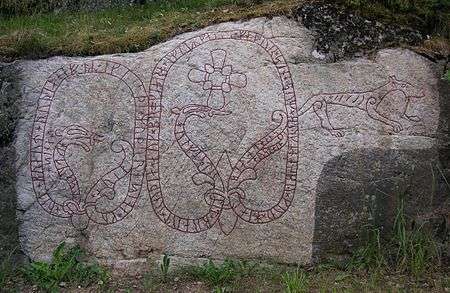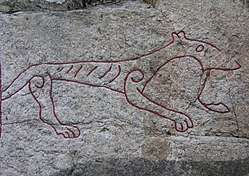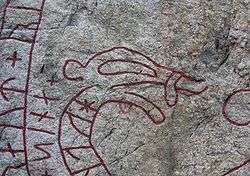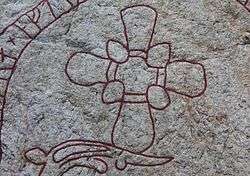Gamla Turingevägen Inscriptions

The Gamla Turingevägen Inscriptions are two Viking Age memorial runic inscriptions and one image that are designated as Sö 311, Sö 312, and Sö 313 in the Rundata catalog, that are located in Södertälje, Stockholm County, Sweden, and in the historic province of Södermanland.
Description

These inscriptions are carved into the granite rockface along the Gamla Turingevägen, or Old Turinge Road, which was once the main road from Stockholm into southern Södermanland, and was the forerunner of the modern Göta highway. The inscription indicates that Holmfast may have had parts of the road cleared at this location in honor of his parents, with the carving of the inscription to memorialize his parents, the work, and its Christian nature.[1] Road and bridge-building as described in the runic text is fairly common in runestones during this time period.[1] At this time, the Catholic Church sponsored the building of roads and bridges in a practice similar to the use of indulgences in return for the church's intercession for the soul of the departed.[2] There are many examples of these bridge stones dated from the eleventh century, including runic inscriptions Sö 101, U 489, and U 617.[2] The inscriptions have been known since the Swedish surveys of runestones conducted in the 1600s, and were recorded as a woodcut illustration in a book published by Johan Hadorph in 1687.[3]
The three carvings are considered to have been made contemporaneously and all made by a runemaster with the normalized name of Östen (Eysteinn in the runic text), with his signature appearing on Sö 312.
The inscriptions are known locally as the Holmfastristningen or "Holmfast carvings" after the current name of the road that passes near them.
Sö 311

Sö 311 consists of runic text carved onto a serpent band. The inscription, which is rather damaged,[1] is 1.2 meters in height and is classified as being carved in runestone style Pr3, which is also called Urnes style. This runestone style is characterized by slim and stylized animals that are interwoven into tight patterns. The animal heads are typically seen in profile with slender almond-shaped eyes and upwardly curled appendages on the noses and the necks.
Inscription
Transliteration of the runes into Latin characters
- hulfastr + lit + braut + ruþia + aftʀ + ik----(þ)i + mu(þ)-r + sina + ku-- + -r-a... + sina +[4]
Transcription into Old Norse
- Holmfastr let braut ryðia æftiʀ Ing[i]..., moð[u]r sina go[ða] ... sina.[4]
Translation in English
- Holmfastr had the path cleared in memory of Ingi-... his good mother ... his.[4]
Sö 312

Sö 312 consists of runic text carved onto a serpent band that circles a Christian cross. The inscription is 1.5 meters in height and is classified as being carved in runestone style Pr4, which is also classified as being an Urnes style. The text in two locations follows the rule that two consecutive identical letters are represented by a single rune, even when the two identical letters are at the end of one word and the start of a second word.[5] This inscription uses one i-rune for the words byki| |i. The inscription is signed by the runemaster Eysteinn, which is normalized as Östen, by simply adding his name at the end of the text without using any verb such as "carved" or "painted."[6] Although such signatures are unusual on runestones, there is another example of an inscription being signed in this manner on Sö 266 in Sanda.[6] This is the only surviving inscription known to have been signed by this runemaster, although two other Urnes style inscriptions, Sö 338 at Turinge and Sö 344 at Kiholm, have been attributed to Östen based upon stylistic grounds.
Inscription
Transliteration of the runes into Latin characters
- hulfastr lit × braut × ryþia × auk × bro kiara iftiʀ gam-- × faþur × sin × sum × byki| |i : nesby × kuþ × hialbi ant hans aystain[7]
Transcription into Old Norse
- Holmfastr let braut ryðia ok bro gærva æftiʀ Gam[al], faður sinn, sum byggi i Næsby. Guð hialpi and hans. Øystæinn.[7]
Translation in English
- Holmfastr had the path cleared and the bridge made in memory of Gamall, his father, who lived in Nesbýr. May God help his spirit. Eysteinn.[7]
References
- 1 2 3 Page, Raymond Ian (1995). Chronicles of the Vikings: Records, Memorials, and Myths. British Museum Press. pp. 55–57. ISBN 0-8020-0803-8.
- 1 2 Gräslund, Anne-Sofie (2003). "The Role of Scandinavian Women in Christianisation: The Neglected Evidence". In Carver, Martin. The Cross Goes North: Processes of Conversion in Northern Europe, AD 300-1300. Boydell Press. pp. 483–496. ISBN 1-903153-11-5. pp. 490-492.
- ↑ Hadorph, Johan (1687). Gothlands-laghen: på gammal göthiska med en historisk berättelse wid ändan, huruledes Gothland först år upfunnit och besatt, så och under Swes rijke ifran hedna werld altijd lydt och sin skatt giordt... (in Swedish). Tryckt aff H. Keyser. p. viii.
- 1 2 3 Project Samnordisk Runtextdatabas Svensk - Rundata entry for Sö 311.
- ↑ Page, Raymond Ian (1987). Runes. University of California Press. p. 22. ISBN 0-520-06114-4.
- 1 2 Jesch, Judith (2001). Ships and Men in the Late Viking Age: The Vocabulary of Runic Inscriptions and Skaldic Verse. Boydell Press. p. 45. ISBN 978-0-85115-826-6.
- 1 2 3 Project Samnordisk Runtextdatabas Svensk - Rundata entry for Sö 312.
External links
Coordinates: 59°11′46″N 17°36′48″E / 59.19611°N 17.61333°E